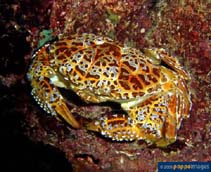| Family: |
Xanthidae (stone and mud crabs) |
| Max. size: |
10 cm CL (male/unsexed) |
| Environment: |
reef-associated; marine; depth range 0 - 10 m |
| Distribution: |
Indo-Pacific: from East Africa to French Polynesia. |
| Diagnosis: |
The carapace has protruding frontal borders which are divided into four lobes (first three are rounded and the fourth is tooth-like. The body is covered with eye-like chocolate brown spots and smooth, well-defined lobules. Both front pincers are of the same size, while the walking legs are fringed with long hairs (Ref. 128968). |
| Biology: |
Adults occur in coral reefs, hidden under rocks during the day. Nocturnal (Ref. 128968). The shell and flesh of this species contain neosaxitoxin, saxitoxin, and tetrodotoxin (Ref. 107779, 128965) which have been proven to be fatal when ingested (Ref. 128965). Intertidal to subtidal (Ref. 106854). Members of the family Xanthidae range from being algal scrapers to aggressive predators (Ref. 103027). |
| IUCN Red List Status: |
Not Evaluated (N.E.) Ref. 123251)
|
| Threat to humans: |
poisonous to eat |
| Country info: |
|
Source and more info: www.sealifebase.org. For personal, classroom, and other internal use only. Not for publication.

